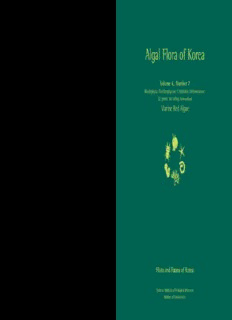
Algal Flora of Korea PDF
Preview Algal Flora of Korea
Algal Flora of Korea Volume 4, Number 7 Rhodophyta: Florideophyceae: Ceramiales: Delesseriaceae: 22 genera including Acrosorium Marine Red Algae Flora and Fauna of Korea National Institute of Biological Resources Ministry of Environment National Institute of Biological Resources Ministry of Environment ISBN 978-89-97462-56-8 Russia CB Chungcheongbuk-do CN Chungcheongnam-do HB GB Gyeongsangbuk-do GG Gyeonggi-do China GN Gyeongsangnam-do YG GW Gangwon-do HB Hamgyeongbuk-do JG HN Hamgyeongnam-do HWB Hwanghaebuk-do HN HWN Hwanghaenam-do PB JB Jeollabuk-do JG Jagang-do JJ Jeju-do JN Jeollanam-do PN PB Pyeonganbuk-do PN Pyeongannam-do YG Yanggang-do HWB HWN GW East Sea GG GB (Ulleung-do) Yellow Sea CB CN GB JB GN JN JJ South Sea Algal Flora of Korea Volume 4, Number 7 Rhodophyta: Florideophyceae: Ceramiales: Delesseriaceae: 22 genera including Acrosorium Marine Red Algae 2012 National Institute of Biological Resources Ministry of Environment Algal Flora of Korea Volume 4, Number 7 Rhodophyta: Florideophyceae: Ceramiales: Delesseriaceae: 22 genera including Acrosorium Marine Red Algae Ki Wan Nam and Pil Joon Kang Pukyong National University Copyright ⓒ2012 by the National Institute of Biological Resources Published by the National Institute of Biological Resources Environmental Research Complex, Hwangyeong-ro 42, Seo-gu Incheon, 404-708, Republic of Korea www.nibr.go.kr All rights reserved. No part of this book may be reproduced, stored in a retrieval system, or transmitted, in any form or by any means, electronic, mechanical, photocopying, recording, or otherwise, without the prior permission of the National Institute of Biological Resources. ISBN : 9788997462568-96470 Government Publications Registration Number 11-1480592-000364-01 Printed by Junghaengsa, Inc. in Korea on acid-free paper Publisher : Sang Pal Lee Project Staff : Youn-Bong Ku, Ga Youn Cho, Jin Hee Kim Published on December 24, 2012 The Flora and Fauna of Korea logo was designed to represent six major target groups of the project including vertebrates, invertebrates, insects, algae, fungi, and bacteria. The book cover and the logo were designed by Jee-Yeon Koo. Preface The adoption of the “Nagoya protocol on access to genetic resources and the fair and equitable sharing of benefits arising from their utilization” in 2010 led to the realization of international stan- dardization in the fulfillment of the biological sovereignty and the exploration and preservation of indigenous biological organisms will play a critical role in enhancing the national development and the international competitiveness. Most developed countries had already organized the information of species inhabiting in their territories to claim their severeignty over those biological resources, but in this respect Korea was outpaced by these countries. In order to effectively secure, use and manage the indigenous biological organisms it is imperative to systematically understand them at the national level and to organize them to publish in the Flora and Fauna of Korea. Recognizing the importance of its securement and management in taking the initiative in bio- industry in future, National Institute of Biological Resources of the Ministry of Environment has been publishing the Flora and Fauna of Korea for systematic and efficient management of biological resources of our own. For the last 5 years, professional research groups consisting of relevant professors and the like conducted systematic surveys and organizations for a variety of and wide range of taxa. As a result, 65 issues of Flora and Fauna of Korea, both in Korean and in English, covering 7,709 species and two issues of world monograph covering 216 species were published and 25 issues of Flora and Fauna of Korea, both in Korean and in English, covering 1,313 species are published this year. These efforts serve not only to identify indigenous species living in Korea and to provide the sci- entific evidences and certifications to claim the sovereign rights over indigenous biological resources in Korea, but also provide the opportunity to prepare the framework for the biotechnological indus- trialization of biological resources. Finally I would like to express sincere appreciation for Professor Ki Wan Nam and Mr. Pil Joon Kang of Pukyong National University who did not spare their efforts to publish Biological Magazine. Sang Pal Lee President NIBR 1 Contents List of Taxa 3 Introduction 5 Materials and Methods 6 Taxonomic Notes 7 1. Apoglossum gregarium(E.Y. Dawson) M.J. Wynne 9 2. Apoglossum minimumYamada 10 3. Caloglossa leprieurii(Montagne) G. Martens 11 4. Caloglossa ogasawaraensis Okamura 12 5. Taenioma perpusillum(J. Agardh) J. Agardh 13 6. Congregatocarpus kurilensis(Ruprecht) M.J. Wynne 14 7. Cumathamnion serrulatum(Harvey) M.J. Wynneet G.W. Saunders 15 8. Membranoptera robbeniensis Tokida 17 9. Neoholmesia japonica(Okamura) Mikami 20 10. Marionella schmitziana(De Toniet Okamura) Yoshida 22 11. Hypoglossum barbatumOkamura 26 12. Hypoglossum caloglossoidesM.J. Wynneet Kraft 29 13. Hypoglossum geminatumOkamura 31 14. Hypoglossum minimumYamada 32 15. Hypoglossum simulansM.J. Wynne, I.R. Priceet D.L. Ballantine 35 16. Yoshidaphycus ciliatus(Okamura) Mikami 37 17. Martensia elegans Hering 38 18. Martensia albidaY. Lee 41 19. Martensia australisHarvey 42 20. Martensia bibarii Y. Lee 43 21. Martensia flammifolia Y. Lee 47 22. Martensia fragilisHarvey 48 23. Martensia jejuensis Y. Lee 50 24. Martensia palmata Y. Lee 52 25. Martensia projecta Y. Lee 53 26. Nitophyllum stellatocorticatumOkamura 55 27. Acrosorium ciliolatum(Harvey) Kylin 58 28. Acrosorium flabellatumYamada 62 29. Acrosorium minus(Sonder) Kylin 63 30. Acrosorium polyneurum Okamura 66 31. Acrosorium yendoi Yamada 72 32. Cryptopleura membranacea Yamada 76 33. Haraldiophyllum bonnemaisonii(Kylin) A.D. Zinova 79 34. Haraldiophyllum udoensisM.S. Kimet J.C. Kang 83 35. Hideophyllum yezoense(Yamadaet Tokida) A.D. Zinova 84 36. Myriogramme livida(J.D. Hookeret Harvey) Kylin 87 2 Algal Flora of Korea·Marine Red Algae 37. Erythroglossum minimumOkamura 90 38. Erythroglossum pinnatumOkamura 93 39. Phycodrys fimbriata(Kuntze) Kylin 95 40. Phycodrys radicosa(Okamura) Yamadaet Inagaki 98 41. Pseudopolyneura koreanasp. nov. 101 42. Pseudopolyneura japonica(Yamada) comb. nov. 104 43. Sorella repens(Okamura) Hollenberg 105 44. Schizoseris bombayensis(Børgesen) S.-M. Lin 109 45. Schizoseris subdichotoma(Segawa) Yamada 113 Literature Cited 116 Index to Korean Names 123 Index to Korean Names as Pronounced 125 Index to Scientific Names 127
Description: